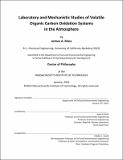| dc.description.abstract | Volatile Organic Compounds (VOCs) oxidize in the troposphere and significantly influence the formation of pollutants including ground-level ozone, CO2, and particulate matter (PM). Ozone and PM negatively impact human health, and all three pollutants influence Earth’s climate. VOCs also dominate the OH reactivity of the atmosphere which in turn influences concentrations of other important radical species including NOx and HO2. Chamber experiments are often conducted to measure VOC oxidation in a controlled laboratory setting, but these studies are may be complicated by vapor deposition on chamber surfaces and potential VOC decomposition in the Chemical Ionization Mass Spectrometers (CIMS) which are used to measure a broad range of oxidation products. Mechanistic simulations are also frequently performed to emulate chamber chemistry with less effort and fewer complications than may arise during a chamber experiment, but the results of these simulations are limited by uncertainties and gaps in our understanding of VOC oxidation chemistry from empirical studies. This thesis addresses uncertainties in chamber measurements and mechanisms and uses both in tandem to provide mutual benefits. Chapter 2 focuses on the development and characterization of a Total Suspended Carbon (TSC) apparatus which may be used to parametrize chamber vapor deposition. Chapter 3 centers around the development of new methodology to compare carbon closure chamber datasets and mechanistic datasets using GECKO-A as the base mechanism. Comparisons suggest a propensity for the decomposition of nitrate, peroxyacyl nitrate, alcohol, and aldehyde functional groups in the process of being detected by CIMS, so the final comparison methodology is based on carbon number and average carbon oxidation state distributions which are largely unaffected by decomposition. Chapter 4 uses the methodology from Chapter 3 to investigate how targeted edits to GECKO-A mechanism generator affect its overall agreement with chamber observations for α-pinene, isoprene, and 1,2,4-trimethylbenzene oxidation studies. This chapter highlights reaction pathways of particular importance for each VOC oxidation system and provides new methods to target pathways and specific reactions for further study. Overall, this thesis provides broadly applicable new tools to reduce uncertainty and improve chemical understanding of VOC oxidation systems. | |
